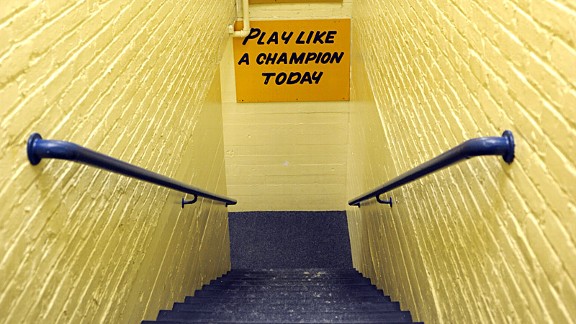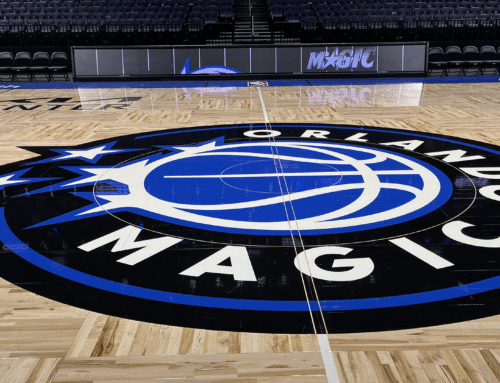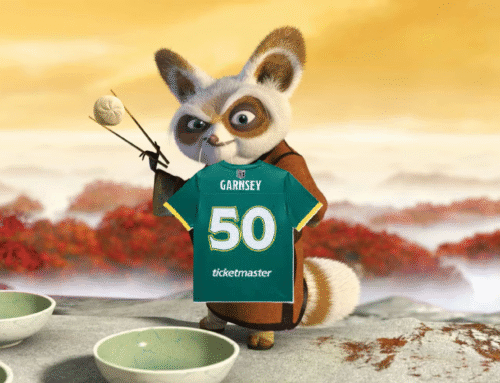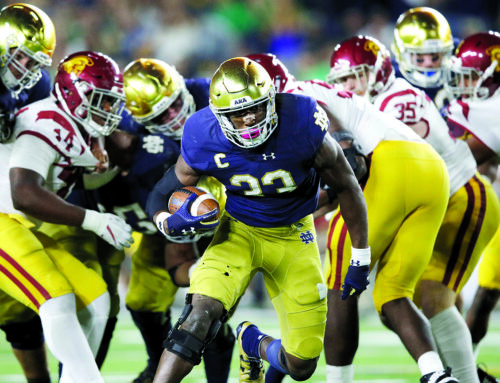It’s time to break out the advanced stats again, taking a glance at the few things that went right and the many things that went wrong in 2016 and predicting how they’ll change this season. Last year I broke out each of Bill Connelly’s Five Factors into it’s own posts, but procrastination has led to one massive mega-preview. Consume in one sitting at your own risk. If you have not read it already, Bill’s 2017 preview from earlier this offseason is an excellent primer for a few topics we’ll go into more depth on here.
Fancy-math definitions for non-nerds:
IsoPPP: Looking just at successful plays (Iso), how successful were they (Points Per Play)? Points per play assigns a value to each success based both on the number of yards gained and where on the field you were. A 20-yard gain from the opponent 35 is more valuable than a 20-yard gain from your own 20, because it more drastically increases your expected points from the drive.
Success Rate: An efficiency metric to see how often your plays are considered a success or failure. There’s been many definitions, but I use Bill Connelly’s since my numbers are then apples to apples with his great work and I can compare more easily. Success is defined as gaining 50% of the yards needed (regardless of run or pass) on 1st down, 70% on 2nd down, and 100% (a new first down) on 3rd and 4th down. An average success rate is typically around 40%.
“Adjusted: or “+”: Indicator of an opponent-adjusted stat that takes into account the quality of opponent
Offense
Explosiveness
Entering last season, it was practically a given that the offense couldn’t replicate 2015’s explosiveness. With Will Fuller making long touchdowns a game-by-game occurrence and CJ Prosise and Josh Adams consistently breaking long runs, the Irish ranked 4th nationally in IsoPPP+ that year. What wasn’t as predictable was the scale of the drop-off – Notre Dame fell to 42nd last season. Besides the obvious departures, what went wrong?
The main culprit was the evaporation of long running plays. The Prosise-Adams-Kizer trio led the Irish to 8th nationally in Rushing IsoPPP in 2015. With Adams and Kizer returning I think most Irish fans banked on the explosive runs continuing, but they fell to a below average 71st in the same category in 2016. There’s plenty of places to point fingers – the offensive line slipped significantly in adjusted line yards (2nd to 18th) and opportunity rate (4th to 46th), making it much harder for runners to make it to the second level.
The running backs also didn’t hold up their end of the bargain – injuries seemed to impact Josh Adams, who say his highlight yards per opportunity (a measure of how far a runner takes advantage of open space) fall from an elite 7.8 to just above average 5.9. Handing some of CJ Prosise’s carries to Tarean Folston also hurt – while Folston had several strong attributes, he was one consistently one of the least explosive backs in the country throughout his career.
Explosiveness in the passing game held up surprisingly well, staying steady at 47th nationally after finishing 48th the previous year. Equanimeous St. Brown did an admirable job in attempting to replace Fuller’s highlight reel production with 16.6 yards per catch. Kevin Stepherson was a pleasant surprise as a true freshman, averaging 18.5 yards per reception. Without adjusting for opponents, where the Irish saw easier passing defenses in 2016, the passing offense was just as explosive, although it fell off in other categories.
2017 Prediction
Both the passing and running offense seem primed for solid gains in explosiveness this year. A healthy Josh Adams is a huge start, as once he seemed to heal up he closed the season with 100 yards on 7.7 YPC versus Virginia Tech and 180 yards on 10.6 YPC at USC. Between Kizer and Folston’s opportunities from last season that opens up 181 carries for Brandon Wimbush, Dexter Williams, and Tony Jones Jr. Each of those respective players should represent upgrades in speed, agility, and big-play ability, and the Irish should only run more this season with a less experienced QB and faster tempo.
The offensive line also figures to be much improved with four strong returning starters, two of All-American caliber. Without reading too much into a small sample size of one season, last year Chip Long’s Memphis running game was strong in creating big plays, ranking 28th in Rushing IsoPPP. All signs point up in the run game.
I see less certainty through the air, where Chip Long last season was more efficient than explosive. The uncertainty beyond St. Brown at wide receiver makes it hard to envision what the passing attack will look like – a more tight-end or running back heavy rotation could lend itself to fewer big plays. Stepherson’s blurry status also doesn’t help – he provides much-needed big-play ability if he can dig his way out from his location six feet under Brian Kelly’s doghouse. Still, the strategy behind the RPO-heavy offense is putting dynamic playmakers in space, and between St. Brown, Cam Smith, CJ Sanders, Chris Finke, and Chase Claypool, there’s plenty of danger there.
Prediction: Improvement to top-25 in IsoPPP+, driven primarily by big increases in rushing explosiveness (top 25 in Rushing IsoPPP) and slight gains in passing (top 40 passing IsoPPP)
Efficiency
The Irish were also 4th in Success Rate+ in 2015, and fell to 26th last year. This category is in the inverse of explosiveness – the passing game fell off more dramatically in 2016 (from 22nd to 45th), and rushing stayed around the same (33rd to 43rd, with only .1% difference in rushing success rate).
In the passing game, DeShone Kizer struggled with consistent accuracy last season without the benefit of as strong of an offensive line as he enjoyed in his debut year. Young receivers likely didn’t help either, but Notre Dame’s adjusted sack rate fell from 52nd all the way to 95th. An underrated loss in addition to Fuller’s explosiveness was the consistency that he provided along with Chris Brown – both had strong catch rates and success rates when targeted above 50%. Last season St. Brown had a strong success rate of 56.8%, and then there was a potpourri of inconsistency – Torii Hunter Jr. was strong when healthy (54.1%), Stepherson was boom or bust (44%), and same with CJ Sanders (46.2%) and Corey Holmes (42.9%).
I was a little surprised to see such similar success rates rushing between 2015 and 2016, but it’s easy to forget that the ’15 rushing attack was a little boom or bust. While very explosive, there were also a high number of negative plays with a stuff rate (plays stopped for zero yards or fewer) that ranked 87th in the country. The ’15 attack also struggled a bit in power run scenarios (3rd and 4th and two or less yards to go), checking in at 58th in the country.
Last season both those crucial efficiency categories saw gains like they’d be training with Matt Balis (sorry / not sorry). The Irish rushing stuff rate improved to 30th in FBS, and despite lack of fullbacks Notre Dame finished 16th in power success rate. If Notre Dame can sustain that improvement and return to more explosiveness, watch out.
2017 Prediction
There are a lot of moving pieces, but overall I think the Irish will end 2017 right around where they finished in Success Rate+ last season. The passing efficiency burden will heavily depend on the shoulders and arm of Wimbush, but he should benefit from a stronger line and more returning production at receiver than Kizer dealt with last season. Chip Long’s offense when clicking should also lead to an increase in easy successful plays – slants and screens to take advantage of defenders caught between responsibilities in helping the run versus pass.
I’m not as optimistic about the rushing attack, despite the strengths at running back and offensive line. On paper the Irish should be much more efficient than a top-40 running unit, but Memphis really struggled with consistent running success last year (85th in rushing success rate). Doing the dangerous and pairing what I’ve seen with my eyes to go with those stats, I think Long’s rushing offense will continue to have some “boom or bust” tendencies. Correctly read RPOs will tear up opponents, but poor reads and missed assignments will increase Notre Dame’s stuff rate again and put the offense in some places where it’s tough to be efficient.
Prediction: Top 25 in Success Rate+, driven by a passing success rate in the top 25 and a rushing success rate that finished in the top 40.
Defense
Explosiveness
The big plays that plagued the Brian Van Gorder era shrank immediately after his dismissal, and the Irish improved from 57th to 36th in Defensive IsoPPP+. The Irish defense was equal generous against the run and pass in 2015, ranking 78th in opponent Passing IsoPPP and 84th in opponent Rushing IsoPPP. In 2016 featured less balance, although some of that was driven by opponents and a monsoon game.
Last year the Irish finished 9th in Rushing IsoPPP and 47th in Passing IsoPPP. We don’t yet have opponent adjusted rankings that break out explosiveness between rushing and pashing, but I think there’s an explanation for the imbalance last season. The schedule featured two service academies, both of which were very efficient and not too explosive last season. More successful (but short) plays drops the IsoPPP average. Similarly, the monsoon game against NC State created a lot of bizarre stats, including making long gains virtually impossible. These circumstances, combined with real improvement filling in against the run and not giving up big plays, helps explain the disparity.
There’s definitely some randomness to giving up big plays, but Van Gorder’s defense and its complexity definitely contributed to an above-average rate of them for several seasons. Players consistently displayed poor fundamentals, lack of understanding of their assignments, and shoddy communication. That there was immediate improvement seen in the last eight games of the season under interim DC Greg Hudson is telling.
2017 Prediction
If we look back at Mike Elko’s past defenses, his teams tend to rank very similarly in efficiency and explosiveness. What stands out is a difference in performance on standard and passing downs – once Elko gets his defenses into a favorable position, he rarely gives up big plays. As Bill Connelly also pointed out in his always-excellent preview, at Wake Forest he dealt with similarly young secondaries and played more conservatively on the back end as a result. It worked well because of two other factors – tightening up in red zone defense and forcing opponents to sustain long drives, which they frequently couldn’t.
Regression will certainly come in the explosiveness allowed by the run defense, but I think under Elko the defense will still contain the run very well. The question marks in the secondary exist moreso in coverage than coming up against the run, and the value of better fundamentals and cohesions could be immense. While the interior defensive line is a concern, the linebackers behind them should be dependable. A top 25 rushing defense in opponent explosiveness seems like a realistic target.
In pass coverage, I think Elko will sacrifice some efficiency for the sake of big-play prevention until he feels more comfortable with Notre Dame’s corners and safeties. Discipline in the secondary will be much improved, and unlike last season there shouldn’t be a ton of true freshman forced into playing time before they’re ready.
Prediction: Slight regression in Rushing IsoPPP is outweighed by solid improvement in Passing IsoPPP, and with opponents adjustments the Irish are a top 25 defense in IsoPPP+.
Efficiency
The Irish defense went a small bit in the wrong direction last season in Success Rate+, dropping from 33rd nationally to 41st. There’s many things to criticize Brian Van Gorder for, but his best strength was probably forcing opponents to be fairly inefficient in his tenure. He caused a relatively high number of opponent three and outs, but the consistent big gains given up negated that advantage.
A number that jumps out looking at Notre Dame’s 2016 advanced stat profile is the opponent passing success rate – 116th in the country. The young Irish secondary kept things in front of them but opponents moved the chains on them fairly easily, including passing downs. A big factor here was the total lack of pass rush (115th in adjusted sack rate), which gave opposing quarterbacks plenty of time to find holes in the defense. The young players improved as the season went along, but so did the competition. Virginia Tech and USC were benchmarks to close the season and indicate the improvement still wasn’t enough to beat opponents with strength at skill positions.
On the ground the ’16 Irish were better, which made sense with a defensive line that featured solid run-stuffers and few pass-rushers. The monsoon game inflates this metric too, but ND finished 46th in opponent rushing success rate. What stands out to me is the inconsistency – week to week it was impossible to predict how well the Irish could stop the run. In consecutive weeks the Irish stymied Miami for a 13.8% run success rate and then gave up 50% successful runs against Navy.
2017 Prediction
In Mike Elko I trust – I see a good leap here even if the defensive scheme is somewhat conservative. I’m banking on a few factors here, including improved havoc that puts the Irish defense in better position to end drives early. Once Notre Dame can force passing downs, Elko’s ’16 defense at Wake was 21st in Passing Down S&P+ and 29th in Passing Down Success Rate. The struggles young players like Devin Studstill, Julian Love, Donte Vaughn, and Jalen Elliott experienced in parts of last season should hopefully translate into meaningful experience to learn from this season.
The passing success rate given up should improve by leaps and bounds, in part because there’s nowhere to go but up. Rushing success rate I think will remain fairly stable – I worry about both quality and depth on the defensive line. Those worries are tempered a little bit by the improvement I expect just because of better fundamentals and scheme, but top-40 seems more realistic than top-25 unless Elko is a real-life wizard.
Prediction: Improvement to top-60 in Passing IsoPPP, and top-40 in Rushing IsoPPP. These aren’t exciting goals, but combined with an improvement in explosiveness will translate into a significantly better defense.
Putting It All Together
There are a lot of reasons for optimism, both in advanced stats and things that they can’t capture. I’d like to invent an advanced stat called VOVG (value over Van Gorder) to quantify the improvement that should be seen simply by virtue of a coherent scheme and consistent fundamentals. Recruiting rankings closely correlate with on-field success, and through the highs and lows of the BK era there are still blue chip bodies that would be luxury for most other teams to have, although aren’t distributed as evenly as the coaches would like. If things go well there will be lots of hypothesized contributors to a turnaround – a slightly new approach for Kelly, new coordinators, better chemistry and leadership, and improved strength and conditioning.
Turnovers and special teams are two areas that I also see improving. On offense, conservatively I think we can expect giveaways to remain similar, while on defense the Elko effect should result in a considerable bump in turnovers gained. It was surprising that special teams took a step back last season with all the key starters returning, but injuries and coverage units seem mostly to blame, and I’m not betting on those results repeating themselves.
Perhaps just as important as all these changes are players believing there’s good reason to be better next year. The placebo effect is a powerful thing, and if the overhauls in these areas can convince talented players, who should be improving anyway by virtue of more experience, that they’ll be good, and that’s confirmed with wins early in the year? Look out.
The sum of the parts above, where I anticipate improvement almost across the board, may still not be enough. If they take what was a top-30ish team last year to a top-20 level, it still could be a 7-5 or 8-4 season against a touch schedule. If those losses include any of the blowout variety and show this team is still a step behind similarly talented teams it will feel wholly unsatisfying even with a doubling in wins.
Many of these projections also rely on staying healthy at positions of need, and there will likely be semi-disastrous consequences if anyone goes down at QB, DT, or in the secondary. The recent streak of close game losses is more likely to be random than anything else, but there’s also the looming possibility that poor late-game decision-making and playing too many close games are root causes that follow this team. Whatever the case, I am excited for the time of questions and hypotheses to end. It’s time for answers, and we’re long overdue for some fun around here.





VOVG – is this like absolute value? No matter what the end result will be positive?
I don’t understand how the value could be anything other than zero. What is 200 times better than zero?
How dare you have an incomplete understanding of WAR!
http://www.fangraphs.com/library/misc/war/
Math is for nerds. I got me a modest cottage in Brendanland. Y’all should move in and be my neighbors. I’m kind of obnoxious, but generally, a good neighbor.
Are there snacks? Because if there are snacks, I’m in.